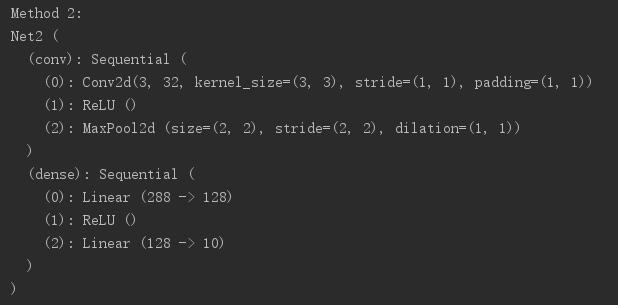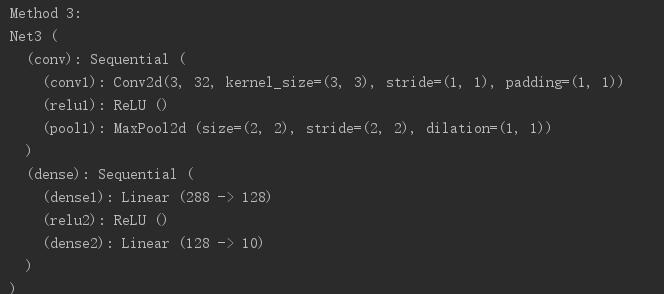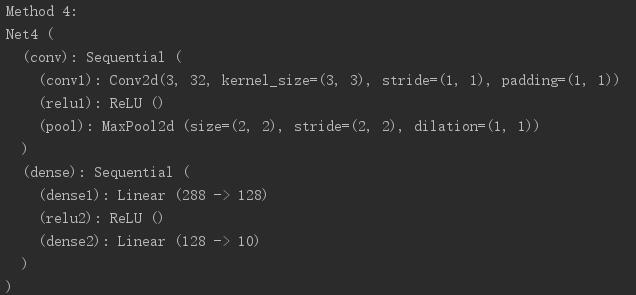利用pytorch来构建网络模型有很多种方法,以下简单列出其中的四种。
假设构建一个网络模型如下:
卷积层--》Relu层--》池化层--》全连接层--》Relu层--》全连接层
首先导入几种方法用到的包:
|
1
2
3
|
import torchimport torch.nn.functional as Ffrom collections import OrderedDict |
第一种方法
|
1
2
3
4
5
6
7
8
9
10
11
12
13
14
15
16
17
18
19
|
# Method 1 -----------------------------------------class Net1(torch.nn.Module): def __init__(self): super(Net1, self).__init__() self.conv1 = torch.nn.Conv2d(3, 32, 3, 1, 1) self.dense1 = torch.nn.Linear(32 * 3 * 3, 128) self.dense2 = torch.nn.Linear(128, 10) def forward(self, x): x = F.max_pool2d(F.relu(self.conv(x)), 2) x = x.view(x.size(0), -1) x = F.relu(self.dense1(x)) x = self.dense2(x) return xprint("Method 1:")model1 = Net1()print(model1) |
这种方法比较常用,早期的教程通常就是使用这种方法。

第二种方法
|
1
2
3
4
5
6
7
8
9
10
11
12
13
14
15
16
17
18
19
20
21
22
23
|
# Method 2 ------------------------------------------class Net2(torch.nn.Module): def __init__(self): super(Net2, self).__init__() self.conv = torch.nn.Sequential( torch.nn.Conv2d(3, 32, 3, 1, 1), torch.nn.ReLU(), torch.nn.MaxPool2d(2)) self.dense = torch.nn.Sequential( torch.nn.Linear(32 * 3 * 3, 128), torch.nn.ReLU(), torch.nn.Linear(128, 10) ) def forward(self, x): conv_out = self.conv1(x) res = conv_out.view(conv_out.size(0), -1) out = self.dense(res) return outprint("Method 2:")model2 = Net2()print(model2) |

这种方法利用torch.nn.Sequential()容器进行快速搭建,模型的各层被顺序添加到容器中。缺点是每层的编号是默认的阿拉伯数字,不易区分。
第三种方法:
|
1
2
3
4
5
6
7
8
9
10
11
12
13
14
15
16
17
18
19
20
21
22
|
# Method 3 -------------------------------class Net3(torch.nn.Module): def __init__(self): super(Net3, self).__init__() self.conv=torch.nn.Sequential() self.conv.add_module("conv1",torch.nn.Conv2d(3, 32, 3, 1, 1)) self.conv.add_module("relu1",torch.nn.ReLU()) self.conv.add_module("pool1",torch.nn.MaxPool2d(2)) self.dense = torch.nn.Sequential() self.dense.add_module("dense1",torch.nn.Linear(32 * 3 * 3, 128)) self.dense.add_module("relu2",torch.nn.ReLU()) self.dense.add_module("dense2",torch.nn.Linear(128, 10)) def forward(self, x): conv_out = self.conv1(x) res = conv_out.view(conv_out.size(0), -1) out = self.dense(res) return outprint("Method 3:")model3 = Net3()print(model3) |

这种方法是对第二种方法的改进:通过add_module()添加每一层,并且为每一层增加了一个单独的名字。
第四种方法:
|
1
2
3
4
5
6
7
8
9
10
11
12
13
14
15
16
17
18
19
20
21
22
23
24
25
26
27
28
29
30
|
# Method 4 ------------------------------------------class Net4(torch.nn.Module): def __init__(self): super(Net4, self).__init__() self.conv = torch.nn.Sequential( OrderedDict( [ ("conv1", torch.nn.Conv2d(3, 32, 3, 1, 1)), ("relu1", torch.nn.ReLU()), ("pool", torch.nn.MaxPool2d(2)) ] )) self.dense = torch.nn.Sequential( OrderedDict([ ("dense1", torch.nn.Linear(32 * 3 * 3, 128)), ("relu2", torch.nn.ReLU()), ("dense2", torch.nn.Linear(128, 10)) ]) ) def forward(self, x): conv_out = self.conv1(x) res = conv_out.view(conv_out.size(0), -1) out = self.dense(res) return outprint("Method 4:")model4 = Net4()print(model4) |

是第三种方法的另外一种写法,通过字典的形式添加每一层,并且设置单独的层名称。
完整代码:
|
1
2
3
4
5
6
7
8
9
10
11
12
13
14
15
16
17
18
19
20
21
22
23
24
25
26
27
28
29
30
31
32
33
34
35
36
37
38
39
40
41
42
43
44
45
46
47
48
49
50
51
52
53
54
55
56
57
58
59
60
61
62
63
64
65
66
67
68
69
70
71
72
73
74
75
76
77
78
79
80
81
82
83
84
85
86
87
88
89
90
91
92
93
94
95
96
97
98
99
100
101
102
103
104
105
|
import torchimport torch.nn.functional as Ffrom collections import OrderedDict# Method 1 -----------------------------------------class Net1(torch.nn.Module): def __init__(self): super(Net1, self).__init__() self.conv1 = torch.nn.Conv2d(3, 32, 3, 1, 1) self.dense1 = torch.nn.Linear(32 * 3 * 3, 128) self.dense2 = torch.nn.Linear(128, 10) def forward(self, x): x = F.max_pool2d(F.relu(self.conv(x)), 2) x = x.view(x.size(0), -1) x = F.relu(self.dense1(x)) x = self.dense2() return xprint("Method 1:")model1 = Net1()print(model1)# Method 2 ------------------------------------------class Net2(torch.nn.Module): def __init__(self): super(Net2, self).__init__() self.conv = torch.nn.Sequential( torch.nn.Conv2d(3, 32, 3, 1, 1), torch.nn.ReLU(), torch.nn.MaxPool2d(2)) self.dense = torch.nn.Sequential( torch.nn.Linear(32 * 3 * 3, 128), torch.nn.ReLU(), torch.nn.Linear(128, 10) ) def forward(self, x): conv_out = self.conv1(x) res = conv_out.view(conv_out.size(0), -1) out = self.dense(res) return outprint("Method 2:")model2 = Net2()print(model2)# Method 3 -------------------------------class Net3(torch.nn.Module): def __init__(self): super(Net3, self).__init__() self.conv=torch.nn.Sequential() self.conv.add_module("conv1",torch.nn.Conv2d(3, 32, 3, 1, 1)) self.conv.add_module("relu1",torch.nn.ReLU()) self.conv.add_module("pool1",torch.nn.MaxPool2d(2)) self.dense = torch.nn.Sequential() self.dense.add_module("dense1",torch.nn.Linear(32 * 3 * 3, 128)) self.dense.add_module("relu2",torch.nn.ReLU()) self.dense.add_module("dense2",torch.nn.Linear(128, 10)) def forward(self, x): conv_out = self.conv1(x) res = conv_out.view(conv_out.size(0), -1) out = self.dense(res) return outprint("Method 3:")model3 = Net3()print(model3)# Method 4 ------------------------------------------class Net4(torch.nn.Module): def __init__(self): super(Net4, self).__init__() self.conv = torch.nn.Sequential( OrderedDict( [ ("conv1", torch.nn.Conv2d(3, 32, 3, 1, 1)), ("relu1", torch.nn.ReLU()), ("pool", torch.nn.MaxPool2d(2)) ] )) self.dense = torch.nn.Sequential( OrderedDict([ ("dense1", torch.nn.Linear(32 * 3 * 3, 128)), ("relu2", torch.nn.ReLU()), ("dense2", torch.nn.Linear(128, 10)) ]) ) def forward(self, x): conv_out = self.conv1(x) res = conv_out.view(conv_out.size(0), -1) out = self.dense(res) return outprint("Method 4:")model4 = Net4()print(model4) |
以上就是本文的全部内容,希望对大家的学习有所帮助,也希望大家多多支持服务器之家。
原文链接:http://www.cnblogs.com/denny402










